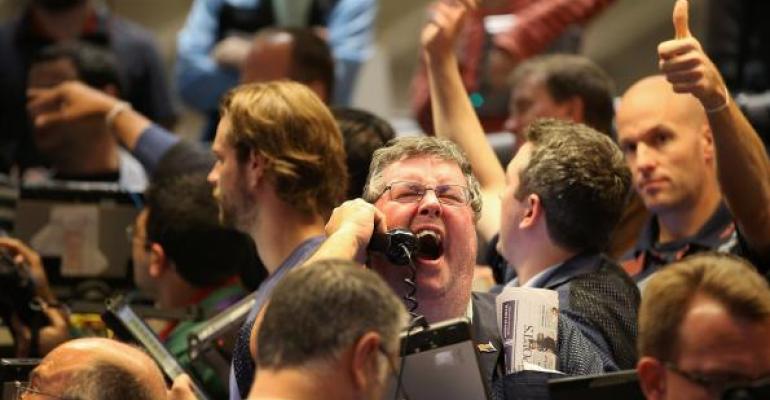By Brian Chappatta
(Bloomberg) --For some, it suggested the end of the Treasuries bull market might be imminent. Others saw it as a chance to reload.
After 10-year U.S. yields broke through 2.4 percent, then 2.42 percent, then 2.45 percent on Tuesday and Wednesday, it looked like the market was buckling under the weight of what DoubleLine Capital LP’s Jeffrey Gundlach called “the moment of truth” for its three-decade bull run. Yet, as has happened time and again, investors saw a buying opportunity, pushing yields back down and leaving traders to assess the damage.
Their conclusion: not-so-fast on the doomsday call. For one thing, the 10-year yield, at about 2.42 percent on Thursday, is still well under its 2017 peak of 2.6277 percent set in March. And nothing much has changed in the bigger picture to merit significantly higher yields. Inflation still remains below the Federal Reserve’s target and the Trump administration has yet to usher in the fiscal stimulus it promised.

In the end, 2.4 percent may prove no more momentous than any other technical level breached since 10-year yields touched a record low of 1.318 percent in July 2016. And if these levels turn out to be merely a way station, investors are eyeing a return to year-to-date highs for a buying opportunity.
“Investors are focused on 2.4 percent as a key level, but we’ve tested higher levels previously this year -- 2.62 percent is more important in my opinion, and we could drift there in the fourth quarter,” said Brian Brennan, who manages U.S. Treasury funds at T. Rowe Price Group. “It’s definitely worth a look at those levels, after 30 years of declining yields.”
Trigger Watch
The impetus for a deeper selloff could come from the U.S. president’s pick to lead the Fed. Treasuries dipped Thursday after Politico reported that current Chair Janet Yellen is out of the running, potentially opening the way to a candidate who’s perceived to be more hawkish. The trigger may also come from overseas. A stronger-than-projected report on U.K. economic growth helped drive U.S. yields higher Wednesday.
Whatever the driver, any push toward higher yields will grab the attention of Gary Pollack, head of fixed-income trading at Deutsche Bank AG’s Private Wealth Management unit.
A 2.6 percent yield “would be a level which would make me take some notice and possibly say ‘Why don’t we just buy some bonds here?”’ he said. “We’ll be looking to take advantage of the oversold position. But it’s too early to call it today.”
Judging by trading activity, some investors aren’t waiting.
The 10-year yield’s climb above 2.47 percent failed to hold Wednesday after domestic buyers swooped in to purchase the front end and intermediate maturities, while overseas investors targeted the 10-year note.
Their interest may be tied to technical analysis, which has defined trading ranges in Treasuries this year. There’s a resistance area for yields at 2.48 percent, the last Fibonacci defense of the rally from March through September.
All Relative
Relative-strength index analysis indicates Treasuries were close to oversold this week. But the selling momentum probably isn’t exhausted, BMO Capital Markets strategists Ian Lyngen and Aaron Kohli wrote in a report Wednesday.
“We tend to favor RSIs at extreme levels, though we’re some distance from a peak that we’d consider a more urgent buying opportunity,” they wrote. Anything between 2.5 percent and 2.6 percent, on the other hand, is “a fairly strong buy level.”
Of course, you can toss momentum indicators out the window if U.S. economic data surpass expectations. The Citigroup Inc. Economic Surprise Index climbed Wednesday to the highest since April on a report showing durable goods orders beat estimates.
The next chance for a surprise comes when the U.S. reports third-quarter economic growth Friday. Gross domestic product probably expanded at a 2.6 percent annual rate, from 3.1 percent the previous three months.
A healthier-than-expected reading, coupled with progress on a tax-overhaul plan, could be enough to jolt traders’ perceptions. So too could an inflation comeback at the end of the year. On the flip side, yields could easily tumble back into the middle of their 2017 range on any disappointment.
“We’ve continued to have head fakes from inflation and growth -- now we’re in one of those periods where the growth stories are beginning to firm up,” said Mitchell Stapley, chief investment officer of ClearArc Capital, which manages $7.5 billion of yield-oriented equity and fixed-income portfolios.
If earnings stay robust and inflation picks up, “people that have stayed with the fixed-income trade for so long are going to start to bail,” he said. Yet if this latest move fades, particularly if a tax package doesn’t materialize, “you’d get a pretty strong run in Treasuries back toward 2 percent.”
--With assistance from Edward Bolingbroke, Sejul Gokal and Elizabeth Stanton.To contact the reporter on this story: Brian Chappatta in New York at [email protected] To contact the editors responsible for this story: Benjamin Purvis at [email protected] Mark Tannenbaum, Dave Liedtka

